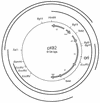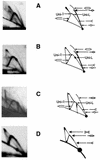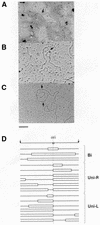Directionality of lambda plasmid DNA replication carried out by the heritable replication complex
- PMID: 11861909
- PMCID: PMC101236
- DOI: 10.1093/nar/30.5.1176
Directionality of lambda plasmid DNA replication carried out by the heritable replication complex
Abstract
There are two 'pathways' of replication of lambda plasmids in Escherichia coli. One pathway requires the assembly of a new replication complex before replication and the second pathway is based on the activity of the replication complex inherited by one of two daughter plasmid copies after a preceding replication round. Such a phenomenon was postulated to occur also in other replicons, including Saccharomyces cerevisiae autonomously replicating sequences. Here we investigated directionality of lambda plasmid replication carried out by the heritable and newly assembled replication complexes. Using two-dimensional agarose gel electrophoresis and electron microscopy we demonstrated that in both normal growth conditions and during the relaxed response to amino acid starvation (when only replication carried out by the heritable complex is possible), bidirectionally and undirectionally replicating plasmid molecules occurred in host cells in roughly equal proportions. The results are compatible with the hypothesis that both complexes (heritable and newly assembled) are equivalent.
Figures






Similar articles
-
Random inheritance of the replication complex by one of two daughter lambda plasmid copies after a replication round in Escherichia coli.Biochem Biophys Res Commun. 1998 May 29;246(3):634-9. doi: 10.1006/bbrc.1998.8711. Biochem Biophys Res Commun. 1998. PMID: 9618264
-
Inheritance of the replication complex by one of two daughter copies during lambda plasmid replication in Escherichia coli.J Mol Biol. 1992 Aug 5;226(3):681-8. doi: 10.1016/0022-2836(92)90625-t. J Mol Biol. 1992. PMID: 1387171
-
Replication and amplification of lambda plasmids in Escherichia coli during amino acid starvation and limitation.FEMS Microbiol Lett. 1997 Aug 1;153(1):151-7. doi: 10.1111/j.1574-6968.1997.tb10476.x. FEMS Microbiol Lett. 1997. PMID: 9252584
-
Inheritance of the replication complex: a unique or common phenomenon in the control of DNA replication?Arch Microbiol. 2001 Feb;175(2):86-93. doi: 10.1007/s002030000245. Arch Microbiol. 2001. PMID: 11285745 Review.
-
Amplification of lambda plasmids in Escherichia coli relA mutants.J Biotechnol. 1995 Dec 1;43(2):139-43. doi: 10.1016/0168-1656(95)00132-5. J Biotechnol. 1995. PMID: 8562019 Review.
Cited by
-
Switch from theta to sigma replication of bacteriophage lambda DNA: factors involved in the process and a model for its regulation.Mol Genet Genomics. 2007 Jul;278(1):65-74. doi: 10.1007/s00438-007-0228-y. Epub 2007 Mar 22. Mol Genet Genomics. 2007. PMID: 17377819
-
A dual promoter system regulating λ DNA replication initiation.Nucleic Acids Res. 2014 Apr;42(7):4450-62. doi: 10.1093/nar/gku103. Epub 2014 Feb 5. Nucleic Acids Res. 2014. PMID: 24500197 Free PMC article.
-
Concise Overview of Methodologies Employed in the Study of Bacterial DNA Replication.Int J Mol Sci. 2025 Jan 7;26(2):446. doi: 10.3390/ijms26020446. Int J Mol Sci. 2025. PMID: 39859162 Free PMC article. Review.
-
Stress responses and replication of plasmids in bacterial cells.Microb Cell Fact. 2002 May 13;1(1):2. doi: 10.1186/1475-2859-1-2. Microb Cell Fact. 2002. PMID: 12076355 Free PMC article.
-
New Insights into the Geometry and Topology of DNA Replication Intermediates.Biology (Basel). 2025 Apr 26;14(5):478. doi: 10.3390/biology14050478. Biology (Basel). 2025. PMID: 40427666 Free PMC article.
References
-
- Taylor K. and WÉgrzyn,G. (1995) Replication of coliphage lambda DNA. FEMS Microbiol. Rev., 17, 109–119. - PubMed
-
- Matsubara K. (1981) Replication control system in lambda dv. Plasmid, 5, 32–52. - PubMed
-
- Furth M.E. and Wickner,S. (1983) Lambda DNA replication. In Hendrix,R.W., Roberts,J.W., Stahl,F.W. and Weisberg,R.A. (eds), Lambda II. Cold Spring Harbor Laboratory Press, Cold Spring Harbor, NY, pp. 145–173.
-
- WÉgrzyn G., Neubauer,P., Krueger,S., Hecker,M. and Taylor,K. (1991) Stringent control of replication of plasmids derived from coliphage λ. Mol. Gen. Genet., 225, 94–98. - PubMed
-
- WÉgrzyn G. and Taylor,K. (1992) Inheritance of the replication complex by one of two daughter copies during λ plasmid replication in Escherichia coli. J. Mol. Biol., 226, 681–688. - PubMed

